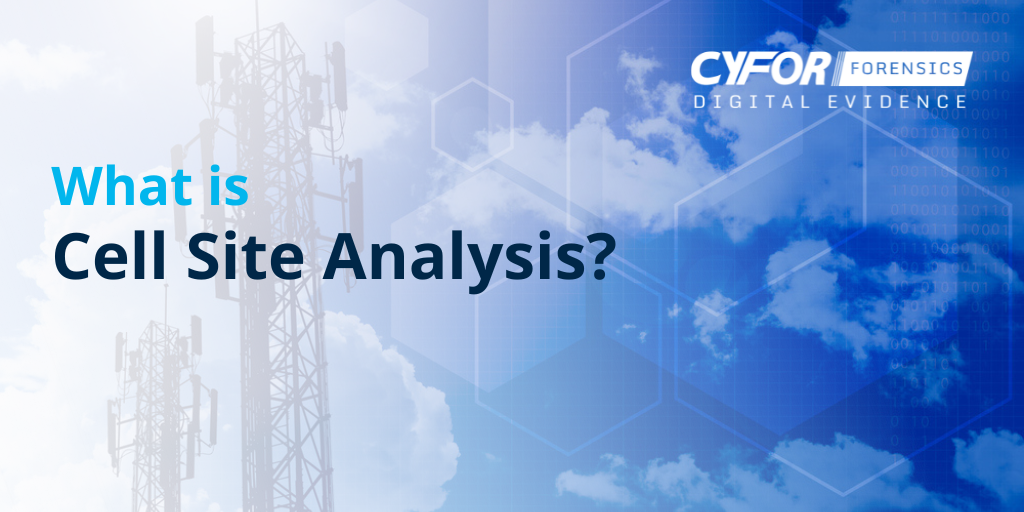CYFOR Blog
The latest industry news and insights

What is Cell Site Analysis?

CYFOR’s in-house cell site experts detail the specifics of Cell Site Analysis, a specialist technique which can provide vital digital evidence within a criminal investigation.
What is Cell Site Analysis?
Cell site analysis is the examination of Call Data Records (CDRs) that are obtained from mobile phone networks. These files contain records of calls made and received, records of text messages sent and received (SMS messages), as well as records of when the phone has used the internet for things such as email and other applications (GPRS sessions).
How does Cell Site Analysis work?
For every call, text or GPRS session there is a record of the cell – sometimes referred to as mast – that is connected to that event in question. The coverage of these cells will likely overlap with multiple other cells and may have a large coverage area or a small coverage area. This will vary from location to location and our experts can help ascertain the coverage area.
As the CDRs give us a location of where the cell is, it can therefore give a general area where the phone in question was located, including potential whether it could or could not have been in a particular location. From this, our analysis can:
- Map out general areas where a phone was at a time, where it frequents, or where it has travelled. This could be of use if the user is visiting a location they shouldn’t be, for example.
- Detail when parties have communicated with each other and how often. This may be of use when parents are not meant to contact one another, for example. Also, whilst this information can be deleted from a phone, the network data is a “golden copy” and cannot be deleted. They store this for 12 months.
- Detail when any SIM swapping has taken place, so where someone is moving their SIM card between different phones. This could be of use if you are trying to identify if someone is hiding a phone from interrogation by the local authority.
- Detail when more than one phone may be colocating, so for example if 2 parents who should not be meeting up are travelling from one area to another to then meet up.
- Detail when more than phones may be separate, so for example if someone is accused of holding a drugs phone when they have not, analysis may show that their personal phone was regularly apart from the drugs phone.
A phone’s location can be determined through the cells used at or directly before and after the time of interest.
Establishing coverage of a cell
A phone’s general location can be determined through the cells used at the time of interest, as well as directly before and after the time of interest. Ascertaining the coverage of the cell used, and therefore whether or not a phone could have been in the coverage of a cell of interest, can be established by:
- Completing a Radio Frequency (RF) Survey, or
- Evidence of opinion of one of our experts.
It is important that this is established, and, where there is evidence already submitted for a case and it has not been established in for that evidence, this is likely to provide points of cross examination following our review of it.
RF Surveys
This is the only method of establishing whether a cell provides service at a location and is the preferred methodology in discussing cell coverage. An RF survey can measure the service area of a cell or cells of interest. Specialist equipment is used to generate measurements of the cells providing service at a location or locations of interest. This location could be:
- An offence location, establishing if the phone could have been at that location.
- An alibi location, establishing if the phone could have been at that location (or as well as the offence location).
- A home address, establishing if a so-called “home cell” does indeed serve at the home address.
Additionally, the survey could span a larger area to establish the coverage or range of a particular cell.
It should be noted that the use of surveyed cells does not prove that the phone was at the location in question, only that it could have been there.
Expert Opinion
The coverage of cells changes over time due to the network environment being updated or altered. This could be due to:
- The addition of cells, meaning what was once a favoured cell at a location is now less favourable than a newer cell installed since the date of the CDRs.
- The cell in question no longer exists (as is the case for 3G cells, with some networks having already switched off 3G and others being switched off soon).
- The cell in question has been replaced with a newer piece of equipment.
Each case is assessed individually to establish whether an RF survey is appropriate. Where an RF survey is not appropriate, opinion of coverage can be provided. Our experts are fully qualified and experienced to provide such opinion for criminal, family, and corporate cases. It is important to note that police officers are not able to give this opinion, and this will be identified in any evidence that is critically reviewed.
Call us today and speak with a Forensic Specialist
Send an enquiry to our experts
After submitting an enquiry, a member of our team will be in touch with you as soon as possible
Your information will only be used to contact you, and is lawfully in accordance with the General Data Protection Regulation (GDPR) act, 2018.